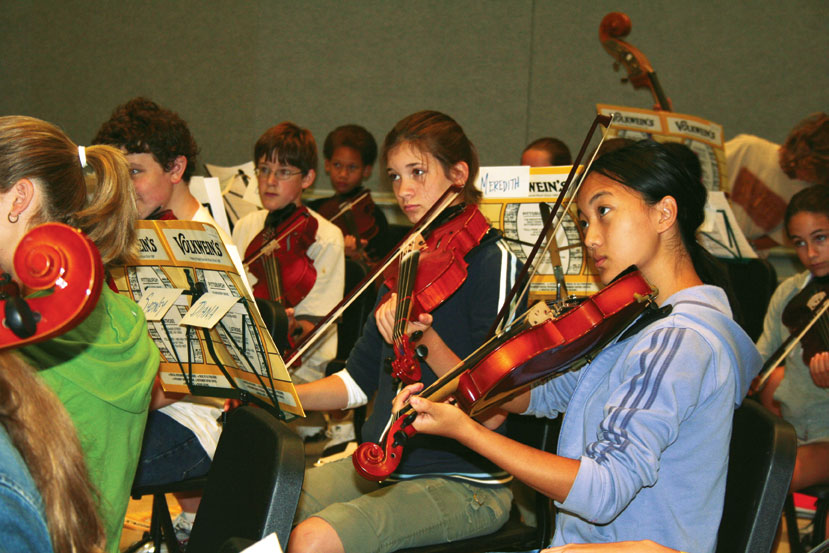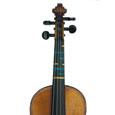Well-meaning string instructors usually mark the fingerboards of instruments with tapes or decals to show finger placement. Beginning students find the tapes helpful because they can easily see where to put their fingers for certain notes.
The use of tapes or decals is a controversial topic among string educators. Many of them question whether adding markers to fingerboards is the best way to instruct beginning students, while others are content to follow custom and use them, preferring to teach in the way they were once taught. There are interesting perspectives from both points of view.
Case Against Tapes
Teachers who argue against marking fingerboards say that tapes or decals are unnecessary props and that they take away from the students’ ability to develop their ears. Beginners who use tapes seem to glue their eyes to the fingerboard, forgetting to watch the teacher or the music. As a result of watching for these markers, they develop poor posture because a natural playing position does not easily facilitate looking at the fingerboard.
Violinists and violists will of-ten play by shifting the scrolls of their instruments too far to the right, making the markers easier to see. Cellists and bassists move the neck of the instrument too far to the left. These contortions quickly become bad habits that grow from the need to look at tapes.
After playing for only a little while, students’ sweaty fingers moisten and shift the tapes. It seems that no matter how accurately teachers position the tapes on the fingerboard, they invariably move so that playing is out of tune.
This is especially true of beginners whose fingers easily slide around as they seek to play the right notes. Finger sliding repositions tapes a milli-meter at a time, but on a string instrument it does not take much before a student is playing out of tune. Teachers regularly have to check the position of the tapes and replace them frequently. It becomes impractical with large groups, and it produces students who learn to play on poorly positioned markers.
As students develop skill, most educators typically remove the tapes, but many instructors question the rationale of teaching something only to take it away later. It is somewhat akin to the way some educators build a crutch for students by placing a violin or viola under the armpit and later taking it away, telling the students to play without it. These students usually have difficulty. Beginning students also flounder when they have to suddenly play without tapes. The notion that they will somehow get the knack of it later does not always work.
We live in an increasingly visual world where everything is point and click, from cameras and personal computers to home video games and car navigation systems. These electronic devices have turned music students into experts at eye-hand coordination, not the eye-ear coordination necessary to perform an instrument well.
Strings easily go out of tune on less-expensive student instruments that do not hold pitch well. Out-of-tune strings encourage players to place their fingers on arbitrary markers and listen less carefully. Even if a student places his finger on a marker correctly, if one string is out of tune, every note on that string will sound out of tune. We have all heard students in recitals playing on tape-laden instruments. If a string suddenly goes out of tune they continue to play, oblivious to good tuning because they are playing on the tapes.
All markers, whether tapes or decals, get in the way of good, natural pitch production. They fray and interfere with the fingers and the natural vibration of the strings. Because of the limited distance between the top of the fingerboard and the bottom of the strings, any type of marker crammed into such a confined area can muffle the string or cause it to buzz. Some teachers solve this problem by increasing the bridge height, but this causes additional performance problems.
A system of tapes can make a beautiful instrument sound like a 12-tone monster. Students begin to produce notes mechanically instead of learning to hear the difference between enharmonic tones, such as the difference in sound between F# in the key of D major and Gb in the key of Eb minor. While it is true that F# and Gb are indistinguishable on a piano, there are important differences in nontempered tuning, depending on the key and the position of the note relative to the scale. These are subtle but important differences.
Most of the great master teachers do not or have not used taped fingerboards with students. The films of Shinichi Suzuki’s violin students from the 1960s show no tape-adorned fingerboards. This teaching philosophy, which he called the “mother tongue,” sharply differs from marking whole steps and half steps with tape or decals.
The landmark videos of Paul Roland teaching at the University of Illinois String Research Project show no one with taped fingerboards, and Niccolo Paganini and the vast majority of most of the other great string players never used them either. If the vast majority of great string players and pedagogues eschewed tapes, I do not understand why current educators insist on using them.
The Value of Tapes
Most teachers agree that using tapes or decals on the fingerboards of beginning string students increases the accuracy of the notes they play. Tapes improve intonation, especially for those who study a string instrument late in life, have a limited musical background, or have less-developed ears.
Although tone-deaf players need some kind of visual marker to find correct finger placement, the idea that decals rob students of the ability to find the right pitch is simply not true. Just consider the hundreds of professional players who began with them.
The antiquated notion that tapes are unnecessary and a crutch is unfounded; tapes merely aid the natural development of learning to play a string instrument. With other skills for example, children learn to walk by steadying themselves on solid objects, they use training wheels to ride a bike, and their teachers sound out difficult words to develop their reading skills.
These techniques break up large, difficult skills into small ones that assist learning, and they are far from being unnecessary crutches. For beginners on string instruments, tapes added to a fingerboard merely facilitate learning by helping students to correctly place their fingers in the absence of a music teacher. At home novice string students usually place their fingers just about anywhere. Dogmatic educators who expect beginners to practice without some type of concrete visual help as to the right place to move the fingers inadvertently encourage poor habits.
Noisy school string classes of 50 or more neophytes who can barely hear themselves play need tapes on their instruments because it is impossible for a student to develop his ears while the person next to him loudly scratches away. In large ensembles or group lessons it is difficult for one teacher to find one-on-one time to develop the ears of each student. Marking fingerboards is the perhaps the only plausible solution.
Tapes greatly benefit players – and their teachers. These markers facilitate learning and develop good left-hand position by training the hand and arm into correct alignment.
Tips for Using Tapes
Most string educators who advocate using some type of marker put tape on all string instruments to indicate the first finger-first position. Beyond that, it gets more complicated. Violinists and violists should probably place tape to mark the third finger in first position, and cellists may have a tape to mark their fourth finger in first position. Bass players can put a tape on their fourth finger in first position.
As far as using a tape for the second finger for violinists and violists and third finger for cellists, most tape advocates put a tape there, but others feel that it is overkill. In addition, violinists and violists will sometimes use a tape for their pinky finger. For basses, some put a tape exactly halfway up the fingerboard for shifting. The number of tapes and their location is a matter of personal preference and should be the result of trial-and-error efforts with experienced teachers.
Color coding the tapes, sometimes with multiple colors, may benefit some students. For example, if a green tape marks first finger, first position, young students easily learn where their pointer finger goes. Multi-colored tapes greatly help those who have not learned note names or finger numbers; in addition it makes the fingerboard fun to learn. Some young students get their fingers mixed up, so using multi-colored tapes helps them navigate the fingerboard. There are also some holographic tapes on the market that can be fun for students to play with.
A number of companies make fingerboard tape, and most of them are good. Boat detailing strips are surprisingly effective and resist being peeled off. Some companies offer pre-cut tape that is easy to apply but more expensive.
When placing tapes, be sure to cut enough length so that the tape overlaps on itself on the underside of the neck. A good tip for width is that violin and viola tape should be about 1⁄8 of an inch; cello and bass tape should be 1⁄4 inch.
The question of when to remove the tapes is also controversial. One simple but obvious guide is to remove fingerboard markings when students stop needing them. Many learners remove tapes themselves when they do not need them anymore. When violinists, violists, and cellists learn to shift, they probably do not need tapes. Some teachers remove tape when the student can play at certain level of difficulty. Certainly they should be removed for most high school-aged students, and advanced players do not need tapes.
Once the tape is removed, fingerboard adhesives leave behind a pesky sticky residue. This residue sometimes seeps out from underneath tapes that are still on the instrument, causing a player’s fingers to stick. Rubbing alcohol can remove the residue, but be careful not to get it on the varnish. Avoid tapes that have too much adhesive on them.
Several companies recently have developed a fingerboard tape system for stringed instruments. The product is a large vinyl sheet with one side of sticky plastic that covers most of the fingerboard; the sheet is marked to show different playing positions. Available for most bowed instrument sizes, these fingerboard systems use a standard distance between positions; there are no individual tapes to shift or peel off.
Many educators view these systems as an improvement over individual tapes that have to be periodically replaced. However, fingerboard tape systems work only if the distance between the bridge and the nut meets the exact specification on the package; otherwise, they will result in out-of-tune playing. Because of the special nature of individual string instruments, these distances can be imprecise and result in some minor out-of-tune playing. There tends to be too many markers on these vinyl fingerboard systems. A beginner needs only five fingerboard positions because anymore becomes confusing rather than helpful.
While the majority of American public school teachers use tapes with their beginning orchestra students, private teachers use them less frequently. There are good reasons explaining each group’s tendencies. When music instructors do not have enough time to work with each student on playing in tune, tapes will help although they should not become an excuse to ignore ear development.
If a string player struggles with tapes, I suggest you see how they do without them and vice versa. Because students learn in different ways, there is no one answer to this debate on whether to add tape to fingerboards. I hope that all string educators will study this subject further and remain flexible in their views on this important topic.





